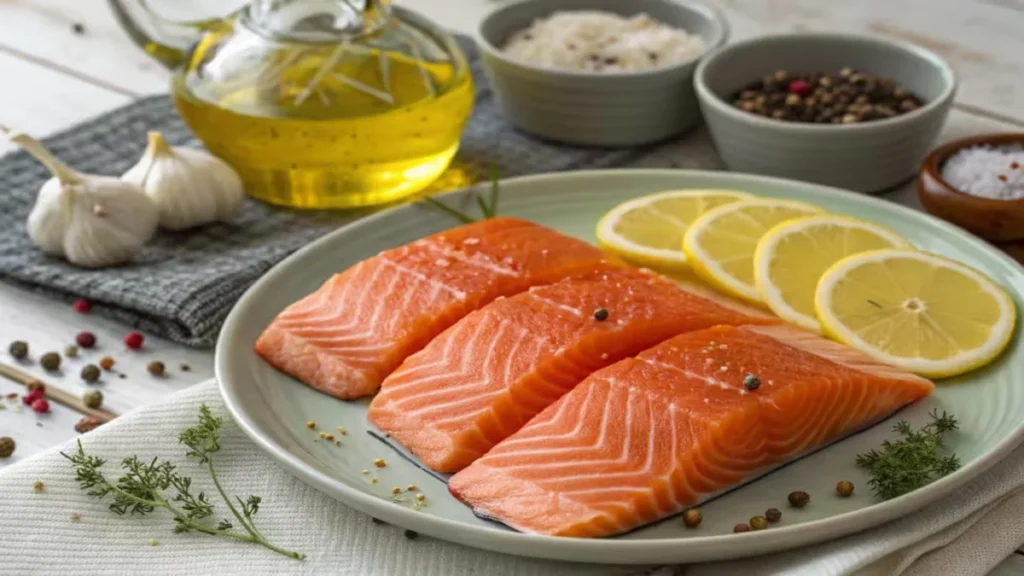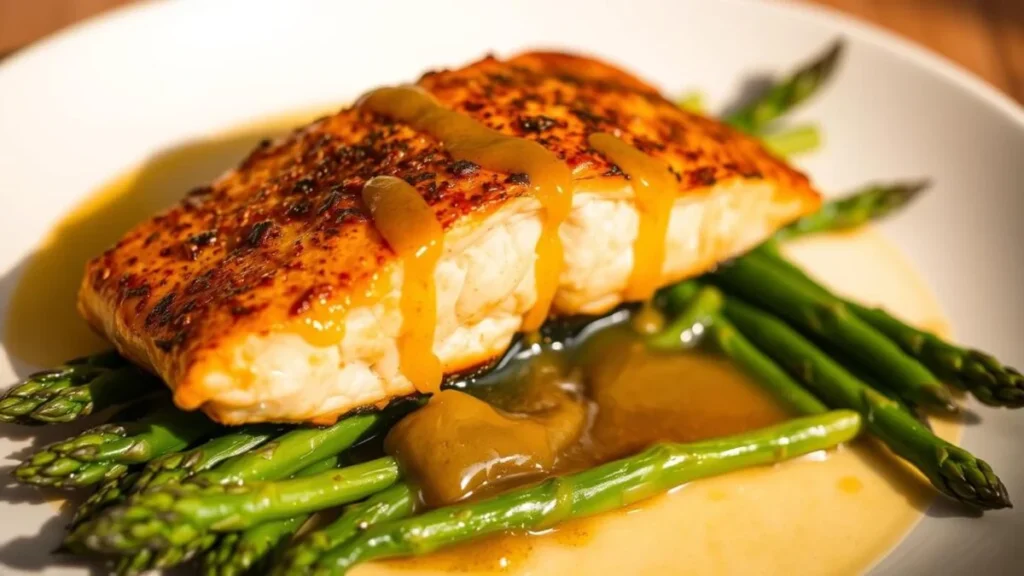Baked Salmon was a game-changer the first time I made it perfectly crispy. The kitchen smelled amazing, filling the air with rich, buttery goodness. That first bite—golden and crunchy on the outside, tender and flaky inside—was pure perfection. Ever since, I’ve been perfecting different ways to make baked salmon even more flavorful and delicious.
Wild Sockeye salmon from Bristol Bay is my favorite. It’s full of omega-3s and looks vibrant red. My method makes it taste like a restaurant dish.
Cooking salmon is easy. Just 15 minutes of prep makes a healthy, tasty meal. These ten tips will make your salmon crispy and tender.
Ready to improve your salmon cooking? I’ll show you how to pick the right cut and season it perfectly. You’ll learn to bake salmon that’s crispy, tasty, and healthy.
Baked Salmon: Essential Preparation Steps for Perfect Results
Making a tasty simple baked salmon needs careful prep. The right steps can make a simple fish taste like a fancy restaurant dish. Let’s go over the key steps to get your salmon fillet crispy and full of flavor.

Selecting the Right Cut of Salmon
Choosing the right salmon is key for a tasty dish. I suggest picking fresh wild-caught salmon if you can. Look for these important traits:
- Bright, vibrant color
- Firm flesh with no discoloration
- Fresh, mild ocean scent
- Uniform thickness for even cooking
Cleaning and Drying Technique
Getting crispy skin starts with cleaning and drying right. Pat your salmon fillet dry with paper towels to get rid of extra moisture. This is key for a crispy outside and even cooking.
| Salmon Type | Recommended Preparation | Cooking Time |
|---|---|---|
| Wild Salmon | Pat dry, room temperature | 15-20 minutes at 375°F |
| Farmed Salmon | Remove excess moisture | 12-14 minutes at 400°F |
Room Temperature Preparation
To bake salmon right, start by letting it get to room temperature. Take the salmon out of the fridge 15-20 minutes before cooking. This helps it cook evenly and prevents overcooking the edges.
Pro tip: A perfectly prepared salmon begins long before it hits the oven!
The Secret to Achieving Crispy Baked Salmon

To get crispy baked salmon, you need to be precise. I’ll share secrets from chefs to make your salmon crispy and delicious.
There are three main things to focus on:
- Skin preparation
- Proper oil application
- Strategic oven positioning
For crispy salmon, bake it skin-side-up. Brush olive oil on the skin and add salt for extra crispiness. Baking at 400°F is best for a golden-brown finish.
| Baking Method | Crispiness Level | Recommended Time |
|---|---|---|
| Foil Baking | Medium | 8-10 minutes |
| Parchment Paper | High | 10-12 minutes |
| Slow-Baked Method | Crispy Exterior | 15 minutes |
Slow-baked salmon is great for an extra crispy outside. It’s all about the right cooking time and temperature.
Pro tip: Pat the salmon skin completely dry before applying oil to ensure maximum crispiness!
Getting crispy baked salmon is an art. It’s about technique, temperature, and timing. Follow these tips to impress your guests every time.
Temperature and Timing: Your Complete Guide
Learning to bake salmon well needs you to know about temperature and timing. Getting the right balance can make your salmon crispy and moist.
Cooking salmon is more than just putting it in the oven. You need to mix temperature, thickness, and cooking method. This way, you get a crispy outside and a soft inside.
Optimal Oven Temperature Settings
Temperature is key when you’re deciding between roasting and baking salmon. Here are the best settings:
- For a quick crisp: 425°F (7-9 minutes)
- For gentle cooking: 350°F (15-20 minutes)
- For air fryer baked salmon: 400°F (12-14 minutes)
Cooking Duration for Different Thicknesses
| Salmon Thickness | Cooking Time | Temperature |
|---|---|---|
| 6-ounce portion | 12-14 minutes | 400°F |
| 2-pound side | 15-20 minutes | 375°F |
Using a Meat Thermometer Effectively
To keep your salmon moist, use a meat thermometer. It’s all about the right temperature:
- Insert thermometer in the thickest part
- Aim for 125°F for medium-rare
- Remove from heat at 140°F (it will continue cooking)
- Final safe temperature: 145°F
Wild salmon needs lower temperatures because it’s firmer. Always choose high-quality fish and handle it right for the best taste.
Seasoning Methods for Extra-Crispy Results
Getting crispy baked salmon is all about seasoning. The right mix can make your fish taste like a restaurant dish. It will also give it a crispy outside that you’ll love.
Dry Rub Combinations for Maximum Flavor
Dry rubs are key for garlic butter baked salmon. They make the salmon taste better and feel different. Here’s what I use:
- ⅔ cup plain breadcrumbs
- ⅔ cup grated parmesan cheese
- ¼ cup finely chopped fresh parsley
- 4 cloves of minced garlic
Oil and Herb Mixtures That Create Crispiness
For a crispy herb-crusted salmon, try an herb-infused oil. It’s all about getting a crispy outside and amazing flavor.
| Herb Mixture | Ingredients | Best Used With |
|---|---|---|
| Classic Herb Blend | Rosemary, thyme, olive oil | Lemon butter baked salmon |
| Spicy Kick | Smoked paprika, cayenne, garlic oil | Honey garlic baked salmon |
| Sweet and Savory | Maple syrup, dijon mustard | Maple glazed baked salmon |
Marinade Options That Promote Crispiness
Marinades do more than add flavor. They help make the salmon crispy. I like using things that caramelize fast for a golden crust.
Pro tip: Dry your salmon well before seasoning. This is key for crispiness. Remember, moisture is bad for crispiness!
The secret to an extraordinary baked salmon lies in understanding how different seasonings interact with heat and protein.
Expert Tips for Restaurant-Quality Baked Salmon
Want to make your baked salmon taste like it’s from a fancy restaurant? I’ve got some secrets from chefs to share. These tips will help you get that crispy outside and juicy inside, no matter the flavor.
For a crispy outside, try using fresh shredded parmesan as a crust. It’s great for many salmon flavors, like teriyaki or Mediterranean.
- Remove salmon from heat when it’s almost done to prevent overcooking
- Finish your cajun baked salmon under the broiler for 2-3 minutes
- Let the fish rest for 3-5 minutes after cooking to lock in juices
When making mustard glazed or dill and lemon salmon, focus on your coating. A light, crisp layer can make your dish taste like a gourmet meal.
Remember, how you present your salmon is just as important as how it tastes. Add fresh herbs, a lemon wedge, and garnish with toasted sesame seeds or green onions. This will make your dish look like it’s from a fancy restaurant.
Final Thoughts: Mastering Your Crispy Baked Salmon Journey
As we finish our cooking journey, let’s talk about how to make your baked salmon crispy. Whether you’re making baked salmon with asparagus or trying a soy sauce recipe, you’ll get better. The tips we shared will help you cook amazing seafood.
Success comes from knowing how to control temperature, season, and prepare. A garlic-flavored baked salmon can be as good as one with parmesan. Each way adds special flavors and textures, making the dish a joy to eat.
Try different flavors, like brown sugar or savory ones. Remember, the more you cook, the better you’ll get. You’ll learn to make that crispy, golden skin that makes salmon so tasty.
Your salmon-cooking adventure begins now. Be open, trust yourself, and try new things. With time and what you’ve learned, you can make salmon as good as in a restaurant.
FAQs
What is the best temperature to bake salmon for a crispy exterior?
Bake salmon at 425°F (218°C) for a crispy outside and moist inside. This high heat makes the outside golden and the inside tender. For thicker salmon, adjust the heat and time for even cooking.
How long should I bake salmon to keep it moist and crispy?
Bake salmon for 12-15 minutes for a 1-inch thick fillet. Cook until it reaches 145°F (63°C). A meat thermometer ensures it’s cooked right without drying out.
Should I bake salmon with the skin on or off?
Bake salmon with the skin on. The skin gets crispy and protects the fish. Pat the skin dry before baking for extra crispiness.
What are the best seasonings for crispy baked salmon?
Use garlic powder, fresh dill, lemon zest, and sea salt. For a crispy crust, try parmesan and herbs or maple-mustard glaze. Cajun seasoning or a simple salt, pepper, and olive oil mix also work well.
Can I bake frozen salmon, or do I need to thaw it first?
You can bake frozen salmon. Add 50% more cooking time and ensure it reaches 145°F (63°C). Pat it dry for a crispy exterior.
What’s the difference between baking salmon in foil versus parchment paper?
Foil traps moisture for tender salmon. Parchment paper allows for crispier skin. For crispy skin, use a bare baking sheet or lightly oiled parchment.
How do I prevent my salmon from drying out?
Avoid overcooking and use these tips: let salmon come to room temperature, pat it dry, and use a marinade or oil. Cook at the right temperature. Remove from oven at 140°F (60°C) for best results.
What are some healthy side dishes to serve with baked salmon?
Serve with roasted veggies like asparagus or broccoli. Quinoa, brown rice, or a green salad are also good. Try a Mediterranean salad with cucumber and tomatoes for a low-carb option.
Can I meal prep baked salmon?
Yes! Store cooked salmon in an airtight container for 3-4 days. Reheat gently to prevent drying. Slightly undercook it initially for better reheating results.
Is baked salmon a healthy meal option?
Yes, salmon is very nutritious. It has protein, omega-3s, vitamin D, and B vitamins. Baking is heart-healthy with little added fat. A 4-ounce serving has about 233 calories, great for heart and brain health.
Table of contents
For more Salmon Recipes Check Out my:
How Long to Bake Salmon at 400°F: A Complete Guide
How to Cook Salmon Perfectly Every Time
How Long to Bake Salmon at 350: A Complete Guide
